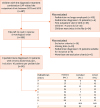2. Hyams JS, Di Lorenzo C, Saps M, Shulman RJ, Staiano A, van Tilburg M. Childhood functional gastrointestinal disorders: child/adolescent. Gastroenterology. 2016; 150:1456–1468.e2.

3. Di Lorenzo C, Colletti RB, Lehmann HP, Boyle JT, Gerson WT, Hyams JS, et al. Chronic abdominal pain in children: a technical report of the American Academy of Pediatrics and the North American Society for Pediatric Gastroenterology, Hepatology and Nutrition. J Pediatr Gastroenterol Nutr. 2005; 40:249–261.


4. Wright NJ, Hammond PJ, Curry JI. Chronic abdominal pain in children: help in spotting the organic diagnosis. Arch Dis Child Educ Pract Ed. 2013; 98:32–39.


5. Rajindrajith S, Zeevenhooven J, Devanarayana NM, Perera BJ, Benninga MA. Functional abdominal pain disorders in children. Expert Rev Gastroenterol Hepatol. 2018; 12:369–390.


6. Yacob D, Di Lorenzo C. How to deal with pediatric functional gastrointestinal disorders. Curr Pediatr Rep. 2013; 1:198–205.

7. Christakis DA, Cowan CA, Garrison MM, Molteni R, Marcuse E, Zerr DM. Variation in inpatient diagnostic testing and management of bronchiolitis. Pediatrics. 2005; 115:878–884.


8. Florin TA, French B, Zorc JJ, Alpern ER, Shah SS. Variation in emergency department diagnostic testing and disposition outcomes in pneumonia. Pediatrics. 2013; 132:237–244.

9. Urkin J, Allenbogen M, Friger M, Vinker S, Reuveni H, Elahayani A. Acute pharyngitis: low adherence to guidelines highlights need for greater flexibility in managing paediatric cases. Acta Paediatr. 2013; 02:1075–1080.

10. Niele N, Willemars L, van Houten M, Plötz FB. National survey on managing minor childhood traumatic head injuries in the Netherlands shows low guideline adherence and large interhospital variations. Acta Paediatr. 2018; 107:168–169.

12. Halm EA, Atlas SJ, Borowsky LH, Benzer TI, Metlay JP, Chang YC, et al. Understanding physician adherence with a pneumonia practice guideline: effects of patient, system, and physician factors. Arch Intern Med. 2000; 160:98–104.


13. Cnossen MC, Scholten AC, Lingsma HF, Synnot A, Tavender E, Gantner D, et al. Adherence to guidelines in adult patients with traumatic brain injury: a living systematic review. J Neurotrauma. 2016; 33:1–14.


14. Jansen PR, Dremmen M, van den Berg A, Dekkers IA, Blanken LM, Muetzel RL, et al. Incidental findings on brain imaging in the general pediatric population. N Engl J Med. 2017; 377:1593–1595.


15. Paul R, Melendez E, Stack A, Capraro A, Monuteaux M, Neuman MI. Improving adherence to PALS septic shock guidelines. Pediatrics. 2014; 133:e1358–66.

16. Nicastro E, Lo Vecchio A, Liguoro I, Chmielewska A, De Bruyn C, Dolinsek J, et al. The impact of e-learning on adherence to guidelines for acute gastroenteritis: a single-arm intervention study. PLoS One. 2015; 10:e0132213.

17. Redaèlli M, Vollmar HC, Simic D, Maly-Schürer C, Löscher S, Koneczny N. Guideline implementation study on asthma: results of a pragmatic implementation approach. Z Evid Fortbild Qual Gesundhwes. 2015; 109:124–131.

18. Maas L, Dorigo-Zetsma JW, de Groot CJ, Bouter S, Plötz FB, van Ewijk BE. Detection of intestinal protozoa in paediatric patients with gastrointestinal symptoms by multiplex real-time PCR. Clin Microbiol Infect. 2014; 20:545–550.








 PDF
PDF ePub
ePub Citation
Citation Print
Print



 XML Download
XML Download